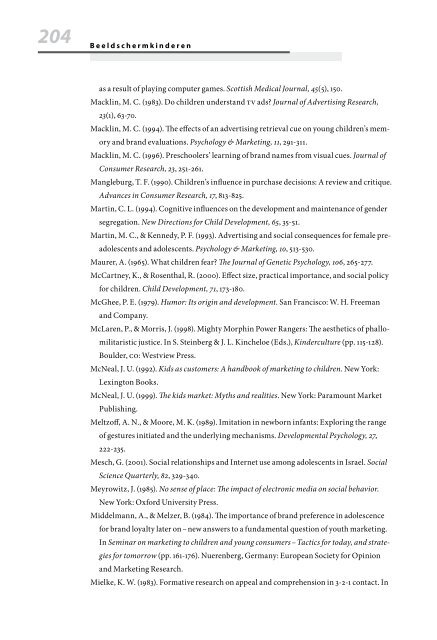Download PDF: Beeldschermkinderen - Kijkwijzer
Download PDF: Beeldschermkinderen - Kijkwijzer
Download PDF: Beeldschermkinderen - Kijkwijzer
Create successful ePaper yourself
Turn your PDF publications into a flip-book with our unique Google optimized e-Paper software.
204 <strong>Beeldschermkinderen</strong><br />
as a result of playing computer games. Scottish Medical Journal, 45(5), 150.<br />
Macklin, M. C. (1983). Do children understand TV ads? Journal of Advertising Research,<br />
23(1), 63-70.<br />
Macklin, M. C. (1994). The effects of an advertising retrieval cue on young children’s mem-<br />
ory and brand evaluations. Psychology & Marketing, 11, 291-311.<br />
Macklin, M. C. (1996). Preschoolers’ learning of brand names from visual cues. Journal of<br />
Consumer Research, 23, 251-261.<br />
Mangleburg, T. F. (1990). Children’s influence in purchase decisions: A review and critique.<br />
Advances in Consumer Research, 17, 813-825.<br />
Martin, C. L. (1994). Cognitive influences on the development and maintenance of gender<br />
segregation. New Directions for Child Development, 65, 35-51.<br />
Martin, M. C., & Kennedy, P. F. (1993). Advertising and social consequences for female pre-<br />
adolescents and adolescents. Psychology & Marketing, 10, 513-530.<br />
Maurer, A. (1965). What children fear? The Journal of Genetic Psychology, 106, 265-277.<br />
McCartney, K., & Rosenthal, R. (2000). Effect size, practical importance, and social policy<br />
for children. Child Development, 71, 173-180.<br />
McGhee, P. E. (1979). Humor: Its origin and development. San Francisco: W. H. Freeman<br />
and Company.<br />
McLaren, P., & Morris, J. (1998). Mighty Morphin Power Rangers: The aesthetics of phallo-<br />
militaristic justice. In S. Steinberg & J. L. Kincheloe (Eds.), Kinderculture (pp. 115-128).<br />
Boulder, Co: Westview Press.<br />
McNeal, J. U. (1992). Kids as customers: A handbook of marketing to children. New York:<br />
Lexington Books.<br />
McNeal, J. U. (1999). The kids market: Myths and realities. New York: Paramount Market<br />
Publishing.<br />
Meltzoff, A. N., & Moore, M. K. (1989). Imitation in newborn infants: Exploring the range<br />
of gestures initiated and the underlying mechanisms. Developmental Psychology, 27,<br />
222-235.<br />
Mesch, G. (2001). Social relationships and Internet use among adolescents in Israel. Social<br />
Science Quarterly, 82, 329-340.<br />
Meyrowitz, J. (1985). No sense of place: The impact of electronic media on social behavior.<br />
New York: Oxford University Press.<br />
Middelmann, A., & Melzer, B. (1984). The importance of brand preference in adolescence<br />
for brand loyalty later on – new answers to a fundamental question of youth marketing.<br />
In Seminar on marketing to children and young consumers – Tactics for today, and strate-<br />
gies for tomorrow (pp. 161-176). Nuerenberg, Germany: European Society for Opinion<br />
and Marketing Research.<br />
Mielke, K. W. (1983). Formative research on appeal and comprehension in 3-2-1 contact. In







